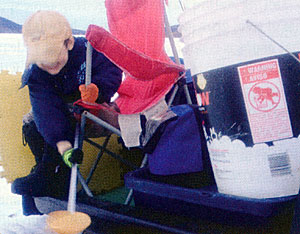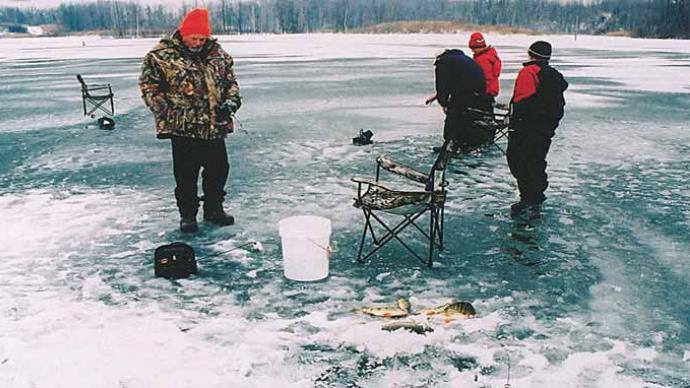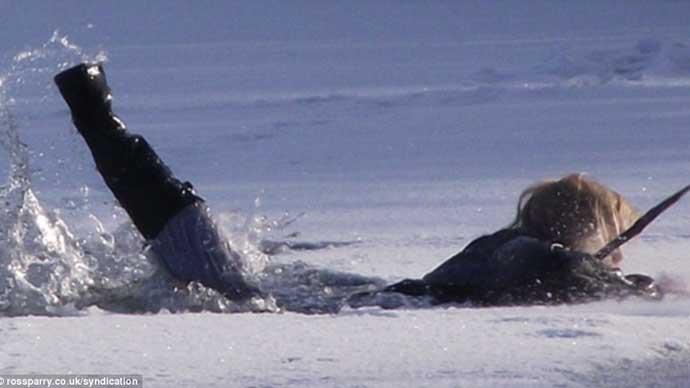
Our weather report for this third week of November in upstate New York lists only two days when the temperature will be above freezing during the day, and that is only by a few degrees. There has already been snow on the ground twice, and the current dusting has lasted 3 days. On several mornings, the horses water tanks have frozen over and the pond has a layer of skim ice on it. It is currently rifle season for whitetail deer in our area, but by the time you read this in January or February, people around here will be ice fishing.
In the state of New York, and in many areas of the United States and Canada, the winter season provides temperatures that are cold enough to freeze over some, many, or all of the bodies of water, depending on what the regional winter temperatures look like. In upstate New York, where I live, by the end of January most ponds, lakes and smaller bodies of moving water, like streams and creeks, will be frozen over and covered in snow. Furthermore, many of those bodies of water will be safe to walk on or even drive on at least with a snowmobile or ATV, and fisher-persons will be out and about drilling holes through the ice to go fishing. That's called ice fishing.
The first and most important thing I need to explain to junior pondmeisters about ice fishing is safety. There are two dangers that must be considered when you are ice fishing. The first is ice safety. Is the ice strong enough to safely hold you, your equipment and your ice fishing friends up above the water?!? I take this consideration very seriously, because I fell through the ice on the edge of the Catskill Creek when I was 5 years old. Even though it has been 35 years since that happened, I can still feel the ice cold water closing in around my body and over my face. I was lucky and got pulled out almost as fast as I fell in, but that's something you remember your entire life, and believe me, you don't want to fall through ice! The general rule agreed upon by multiple state and federal agencies is that new clear ice should be four inches thick to be determined safe for general ice fishing use.

Cloudy ice and snow ice require at least twice that thickness (or eight inches) to be safe because it is not as hard as clear ice. Cloudy ice is formed when the ice is either mixed with snow or the ice has been covered with snow. When clear ice has thawed and refrozen several times it becomes cloudy ice.
Thinner ice may be able to support the weight of a full grown man, but that four inch rule for clear ice allows for natural variation in the ice. Ice will very often be thicker in some places than others. If you measured three inches, which is mathematically strong enough to hold up a full grown man, but measured at the thickest part of the ice in the area, there might be thinner ice only a few steps away and then you would be in trouble. With regard to children and ice, I am very firm that six inches is mandatory, especially since we rarely get four inches of truly clear ice in this part of New York, and often at least some of the ice cover is cloudy.
How do you measure ice thickness? Start near the shore, drill a small hole, and measure the thickness. Measure again several feet farther from shore, and so forth until you determine how many inches of ice cover the water.

The second safety issue is exposure. Ice fishing is a sport in which you go and stand or sit out on a big body of ice for long periods of time, often without a lot of shelter. In some areas, like northern Minnesota, the ice is so thick people drag heated ice shanties, or cabins, out onto the ice to fish out of, and they drive their cars to and from the shanties. But in many other areas of the United States, the ice is not thick enough or frozen long enough to make that a standard practice. With or without a shanty, ice fishing is cold business.
You need to dress properly in lots of layers and with hats, gloves and very warm boots. If there is slush on the ice you will need waterproof boots and back up boots and socks. I also recommend a complete change of warm clothes be kept in your vehicle, just in case.
It is very important to stay hydrated when you are in the cold, we lose lots of moisture through breathing in the cold, dry air, so bring plenty of drinks, preferably warm ones like tea or cocoa or even just plain warm water in a good thermos. And, ice fishing makes most people very hungry, so bring lots of easy to eat snacks. If you bring a heater, you can enjoy some tasty canned soups or stews!
Lastly, if you are including smaller children in your ice fishing adventure you need to remember to take into account that they get colder, hungrier and bored faster than adults and older children. If your point is to get them out fishing so they have fun and want to do it again (or the only way you can get out onto the ice with your family is if your younger siblings tag along), then you may have to make some accommodations.
For our preschool aged son, we take the weather into account first, because there are some days that dad will have fun fishing, but our little boy will not. Second, we pack lots of snacks and drinks and some of those snacks and drinks are special goodies that mom does not generally permit, which helps make ice fishing even more of a treat.

The fishing location is important, too. Kids typically have fun catching anything and do better in active pan fishing sites than sitting around waiting for that one huge laker to bite sometime during the day. And lastly, dad brings his iPhone, with plenty of data, so that during lulls they can watch cartoons. We also fish with a portable ice shanty which has the benefits of making the conditions more comfortable and also allows our son to ride on the shanty on the way out to the fishing site, so he is not forced to trudge through a quarter to a half mile of slush and snow. When the ice gets thicker we sometimes drag the shanty with an ATV, which makes getting to the ice fishing spots even easier and frankly more exciting for our son.
Like all kinds of fishing, the equipment you need depends a little bit on what you want to fish for, how much stuff you feel like carrying and taking care of, and how much cool stuff you can get ahold of. At the very least, you need an ice auger or a spud bar to cut a hole in the ice, fishing lines, hooks, and bait appropriate for the fish you want to catch. Most likely, you'll need something to sit on. Ice is cold! If you carry your stuff out onto the ice in a 5-gallon pail you can sit on that and not have to carry chairs.
As a child, I ice fished with line wrapped around an 8 inch long piece of 1x6" board with v-shaped notches cut in the ends to keep the line from falling off. My husband has us fishing with ice-fishing jigging rods equipped with reels, and we usually use shelter and have comfy camp chairs, and often even a lantern that provides some heat in the shanty and can be used to warm a can of soup or snack. But as long as you have a hook, some bait and line, and a way to make a hole in the ice you can give it a shot!!
You might wonder where on a pond to ice fish. That's easy. You fish where the fish are, all over the pond. Choose a spot, drill a hole and drop in your line. If you don't get any bites, move to another spot, just like regular fishing.
Ice fishing is a fun-filled way to enjoy fishing during the winter months, but special considerations should be taken because of where you are fishing, and the weather associated with ice fishing. It is not for everyone, but it can be a great way to pass the time in the winter, and get some fun fishing done too!
Reprinted with permission from Pond Boss Magazine




